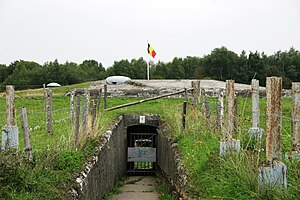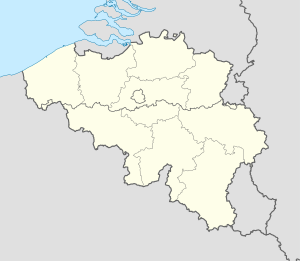Fort de Tancrémont
| Fort de Tancrémont | |
|---|---|
| Part of Fortified Position of Liège | |
| Pepinster, Belgium | |
 |
|
| Coordinates | 50°33′11″N 5°47′27″E / 50.55295°N 5.79094°E |
| Type | Fort |
| Site information | |
| Controlled by | Belgium |
| Open to the public |
Yes |
| Condition | Preserved |
| Site history | |
| Built | |
| Materials | Reinforced concrete, deep excavation |
| Battles/wars | Battle of Belgium |
The Fort de Tancrémont is a Belgian fortification located about 3 kilometres (1.9 mi) south of Pepinster. The fort was built in the 1930s as part of the fortified position of Liège, augmenting the twelve original forts built to defend Liège in the 1880s with four more forts closer to the Belgian frontier with Germany. The fort was the last Belgian fort to surrender to German forces in the opening days of World War II, following the dramatic assault on Tancrémont's sister fort, Fort Eben-Emael. Tancrémont has been preserved and may be visited by the public.
The fort is the southernmost of the four 1930s forts, located about 18 kilometres (11 mi) southeast of Liège. Tancrémont and Fort d'Aubin-Neufchâteau are smaller than Eben-Emael and Fort de Battice. Collectively, the line was known as the Fortified Position of Liège I (Position Fortifiée de Liège 1 (PFL I) ), the original Liège forts constituting PFL II.
The Fort de Tancrémont was a development of the original Belgian fortifications designed by General Henri Alexis Brialmont before World War I, a relatively compact ensemble of gun turrets and observation posts disposed on a central massif of reinforced concrete, surrounded by a defended ditch. This was in contrast with French thinking for the contemporary Maginot Line fortifications, which were based on the dispersed fort palmé concept, with no clearly defined perimeter, a lesson learned from the experiences of French and Belgian forts in World War I. The new Belgian forts, while more conservative in design than the French ouvrages, included several new features as a result of World War I experience. The gun turrets were less closely grouped. Reinforced concrete was used in place of plain mass concrete, and its placement was done with greater care to avoid weak joints between pours. Ventilation was greatly improved, magazines were deeply buried and protected, and sanitary facilities and general living arrangements for the troops were given careful attention. Tancrémont was among the smaller of the new Belgian forts, armed with a maximum gun caliber of 75mm. These guns did not have sufficient range to provide mutual support between neighboring fortifications.
...
Wikipedia

